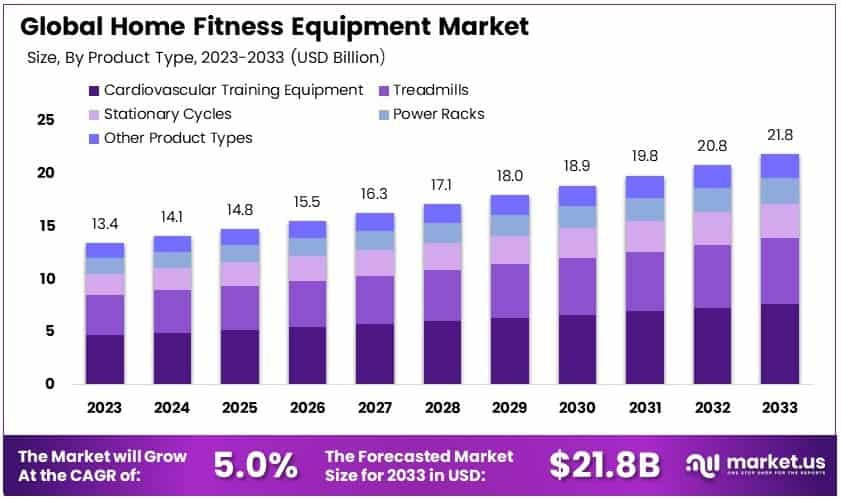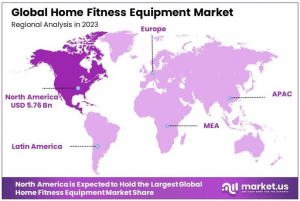
Home Fitness Equipment Market to Hit USD 21.8 Billion by 2033 at 5.0% CAGR

Home Fitness Equipment Market Size
Home Fitness Equipment Market size is expected to be worth around USD 21.8 Bn by 2033, from USD 13.4 Bn in 2023, growing at CAGR of 5.0% during forecast period.
NEW YORK, NY, UNITED STATES, January 22, 2025 /EINPresswire.com/ -- Report Overview
According to the report by Market.us, the global Home Fitness Equipment Market was valued at USD 13.4 Billion in 2023 and is projected to reach USD 21.8 Billion by 2033, growing at a CAGR of 5.0% during the forecast period from 2024 to 2033.
The market includes a wide range of fitness equipment used for at-home workouts, such as treadmills, stationary bikes, resistance training equipment, and more. With the growing emphasis on health and fitness, especially post-pandemic, home fitness equipment has become an essential part of maintaining an active lifestyle. As consumers continue to prioritize convenience and wellness, the market is set to expand globally, offering both traditional and technologically advanced products like smart fitness devices and connected gym equipment.
This report also provides a detailed regional analysis, highlighting North America’s market leadership with a 43.0% share, as well as significant growth opportunities in emerging markets such as Asia-Pacific and Latin America. The market is supported by factors like increasing health awareness, government wellness campaigns, and the proliferation of digital fitness platforms.
For a better understanding, refer to this sample report, which includes corresponding tables and figures @ https://market.us/report/home-fitness-equipment-market/request-sample/
Key Takeaways
~ The Home Fitness Equipment market is projected to grow from USD 13.4 Billion in 2023 to USD 21.8 Billion by 2033, registering a CAGR of 5.0%.
~ Cardiovascular training equipment dominates the market, capturing 35.2% of the market share, fueled by home workout trends.
~ Online platforms lead the distribution channel segment, comprising 54% of sales, highlighting the shift toward e-commerce for fitness products.
~ Gym-in-apartments continues to dominate the end-user segment, showing a preference for integrated fitness solutions in residential complexes.
~ North America holds the largest market share, contributing 43.0% of global revenue, driven by high consumer spending and health-conscious trends.
Regional Analysis
The Home Fitness Equipment market is experiencing strong regional growth, with North America leading the charge with a 43.0% market share, primarily due to high health awareness and an established fitness culture. The U.S. remains the largest market in this region, followed by Canada, both benefitting from robust e-commerce platforms and a preference for premium home fitness products. Europe follows closely, with increasing interest in eco-friendly fitness solutions and rising health consciousness.
In the Asia-Pacific region, rapid urbanization and the growing disposable income in countries like China, India, and Japan contribute to a surge in demand for fitness equipment. Latin America and the Middle East & Africa are expected to see gradual but steady growth, fueled by rising health awareness and greater access to digital fitness services. Emerging markets present significant opportunities as more consumers in these regions adopt home fitness solutions.
Report Segmentation
By Product Type
The Home Fitness Equipment market is segmented into various product types, including treadmills, cardiovascular training equipment, stationary cycles, power racks, and other fitness machines. Cardiovascular training equipment holds the largest market share, with products like ellipticals, rowing machines, and stair climbers being highly sought after for their comprehensive health benefits. Treadmills are particularly popular among consumers focused on running and walking, while stationary cycles appeal to those looking for low-impact workouts. Power racks cater to strength training enthusiasts, offering an essential tool for weightlifting and muscle building. The segment of "Other Product Types" includes compact equipment and resistance bands, which are gaining traction among consumers due to their affordability and convenience in small spaces.
By Distribution Channel
Distribution channels for home fitness equipment are broadly categorized into online platforms and offline stores. Online platforms dominate with a 54% market share, driven by the convenience, variety, and competitive pricing offered by e-commerce platforms. Consumers can easily compare products, read reviews, and have large equipment delivered to their doorsteps. The growing reliance on online shopping, particularly post-pandemic, is expected to continue driving this trend. Offline stores, while representing a smaller portion of the market, still play an important role, especially for customers who prefer to test products before making a purchase. These stores provide hands-on experience, professional advice, and the immediate gratification of purchasing equipment on-site.
By End-User
The end-user segment of the Home Fitness Equipment market is divided into households, gym-in-apartments, and apartments. The 'Gym-in-apartments' segment leads, reflecting the growing trend of residential buildings offering fitness facilities as a key amenity to attract tenants. This allows residents to access fitness equipment without leaving their homes, promoting a more active lifestyle. Households represent a significant portion of the market, with consumers increasingly investing in fitness equipment for personal use in their homes. This is especially true for individuals and families who prefer exercising in a private, convenient space. The 'Apartments' category refers to residents of apartment buildings that may not have dedicated gyms but are still investing in fitness equipment for personal use, often within the limited space of their homes.
Key Market Segments
By Product Type
~ Treadmills
~ Cardiovascular Training Equipment
~ Stationary Cycles
~ Power Racks
~ Other Product Types
By Distribution Channel
~ Online Platforms
~ Offline Stores
By End-User
~ Households
~ Gym in Apartments
~ Apartments
Get the Full Report Today and Save Up to 30%! @ https://market.us/purchase-report/?report_id=64783
Driving Factors
The home fitness equipment market is experiencing robust growth due to several driving factors. Rising health consciousness and the increased desire for convenient at-home workout solutions have propelled this market forward. The COVID-19 pandemic significantly accelerated the adoption of home fitness equipment as gyms closed and consumers sought alternatives to maintain their exercise routines. Advances in technology, such as virtual training sessions, wearable integration, and smart equipment that tracks performance metrics, further enhance user engagement and motivation. Additionally, a growing body of research highlighting the benefits of regular physical activity for mental and physical health encourages more households to invest in home gym setups. Manufacturers are responding with innovative, space-saving designs and multifunctional equipment suited for smaller living spaces. These combined factors, along with increased disposable income and the desire for personalized fitness experiences, drive sustained growth in the home fitness equipment market.
Restraining Factors
Despite its growth, the home fitness equipment market faces several restraining factors. High initial costs for quality equipment can deter budget-conscious consumers, limiting market penetration. Additionally, the space limitations in urban apartments may restrict the purchase of larger fitness apparatus, influencing consumer choices. Lack of motivation and inconsistent exercise habits among users often lead to equipment underutilization, reducing perceived value. The market is also challenged by intense competition, making differentiation difficult for new entrants. Moreover, economic downturns or reduced consumer spending on non-essentials can impact sales. Quality concerns, such as durability and safety of equipment, may lead to consumer hesitation. Potential supply chain disruptions and rising manufacturing costs could also affect affordability and availability. These factors collectively create challenges for market expansion and sustained consumer interest.
Trending Factors
The home fitness equipment market is shaped by several trending factors that align with evolving consumer preferences and technological innovations. One prominent trend is the integration of smart technology into fitness devices, offering connected experiences through companion apps, real-time feedback, and virtual classes. Compact, multifunctional equipment designed for limited spaces is gaining popularity, catering to urban dwellers. Subscription-based fitness services bundled with equipment purchases provide added value and foster long-term engagement. Eco-friendly materials and sustainable manufacturing processes are also emerging as important considerations for environmentally conscious consumers. Manufacturers are focusing on personalized workout solutions, leveraging data analytics and AI to tailor exercise programs to individual needs. Social media influences and community-building features within fitness apps encourage shared experiences and accountability. These trends reflect a market that is increasingly tech-savvy, user-centric, and responsive to lifestyle changes and preferences.
Investment Opportunities
Investment opportunities in the home fitness equipment market are diverse and promising, driven by increasing consumer demand and technological advancements. Investors can focus on startups developing innovative, space-saving equipment designs and smart fitness solutions that integrate with health apps and wearable devices. Funding research into new materials and sustainable manufacturing practices offers potential for companies to stand out in an environmentally conscious market. There are opportunities to invest in digital platforms offering subscription-based virtual training and interactive fitness communities that complement physical equipment. Strategic partnerships between equipment manufacturers and technology firms can accelerate product innovation and market reach. Emerging markets present growth potential as rising incomes and health awareness boost demand for home fitness solutions. Additionally, acquisitions of established brands looking to expand their digital offerings or international presence can provide immediate market access and diversification benefits. These investment avenues promise strong returns as the market continues to evolve.
Market Companies
The Home Fitness Equipment market is highly competitive, with several well-established companies leading the space. Key players include Johnson Health Tech Co. Ltd., Icon Health & Fitness, Inc., Fitness World AS, and Amer Sports Corporation. These companies maintain strong market positions through diverse product portfolios, continuous innovation, and strong global distribution networks. Icon Health & Fitness, with brands like NordicTrack and ProForm, leads the market by focusing on high-tech, connected fitness equipment. Johnson Health Tech and Fitness World AS offer a range of affordable and versatile products catering to different fitness levels and preferences. Amer Sports, with brands like Precor and Wilson, targets premium users with high-quality machines. These companies continuously evolve with consumer preferences, integrating digital fitness solutions and expanding into emerging markets to meet the growing demand for home fitness equipment.
Key Players
~ Johnson Health Tech Co. Ltd.
~ Icon Health & Fitness, Inc.
~ Fitness World AS
~ Amer Sports Corporation
~ Core Health & Fitness, LLC
~ Nordic Track
~ ProForm
~ Hoist Fitness Systems
~ Nautilus, Inc.
~ Other Key Players
Conclusion
The home fitness equipment market has surged, driven by growing health awareness, convenience, and the shift to home workouts post-pandemic. Smart, connected devices and on-demand fitness platforms are reshaping consumer preferences. Opportunities exist in personalization and tech integration, despite challenges like high costs and market saturation in some regions.
Related Reports
Fitness Tracker Market - https://market.us/report/fitness-tracker-market/
Virtual Fitness Market - https://market.us/report/virtual-fitness-market/
Functional Fitness Equipment Market - https://market.us/report/functional-fitness-equipment-market/
Fitness Equipment Market - https://market.us/report/fitness-equipment-market/
Sports Tourism Market - https://market.us/report/sports-tourism-market/
Sports Shoes Market - https://market.us/report/sports-shoes-market/
Soccer Sportswear Market - https://market.us/report/soccer-sportswear-market/
Lawrence John
Prudour
+91 91308 55334
email us here
Visit us on social media:
Facebook
LinkedIn
Distribution channels: Sports, Fitness & Recreation
Legal Disclaimer:
EIN Presswire provides this news content "as is" without warranty of any kind. We do not accept any responsibility or liability for the accuracy, content, images, videos, licenses, completeness, legality, or reliability of the information contained in this article. If you have any complaints or copyright issues related to this article, kindly contact the author above.
Submit your press release

